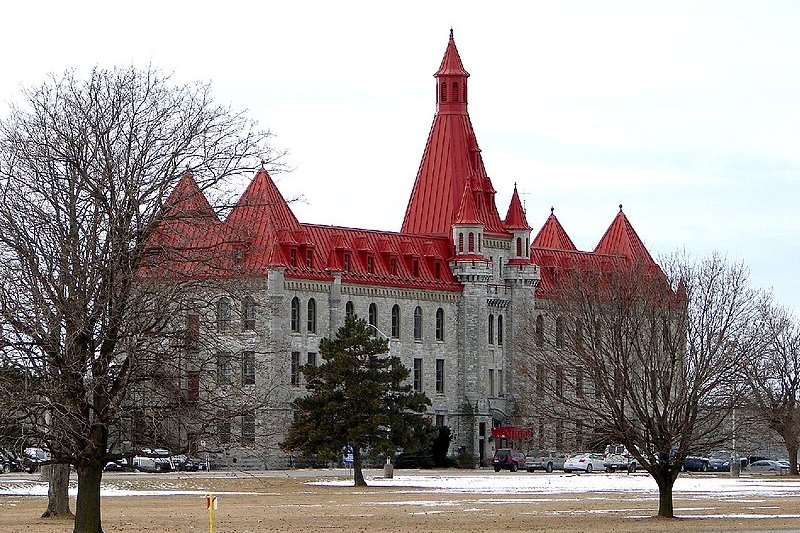 Toronto skyline, Ontario
Toronto skyline, OntarioSource: https://en.wikipedia.org/wiki/File:Skyline_of_Toronto_viewed_from_Harbour.jpg
Author: John Vetterli

Cities and Sights in Ontario
Ontario (ON) is the most populous province or territory of Canada. Located on the central eastern part of the country, it is also the location of its biggest city, Toronto, and the national capital, Ottawa.
Ontario covers 1,076,395 sq km (415,598 sq mi) and has a population of 12.9 million people (2012 estimate). In terms of size, it is the fourth largest province or territory of Canada (behind Nunavut, Quebec and Northwest Territories). It is one of the founding members of the Confederation of Canada on 1 July, 1867, along with Quebec, Nova Scotia and New Brunswick. It has 106 seats on the 308-seat Canadian House of Commons and 24 seats on the 105-seat Senate of Canada.
 Lake Huron shoreline, Bruce Peninsula, Ontario
Lake Huron shoreline, Bruce Peninsula, OntarioSource: https://commons.wikimedia.org/wiki/File:Brucesky.jpg
Author: Brucegirl

Ontario is bordered by Manitoba to the west, Quebec to the east and the US states of Minnesota, Michigan, New York, Ohio and Pennsylvania to the south. It faces Hudson Bay to the north. Apart from a small section of land border, Ontario is separated from the United States by different bodies of water.
Ontario has the biggest GDP of any province or state in Canada, at C$614 billion (2009). Its GDP per capita ranks sixth, at C$43,847. Manufacturing is the biggest contributor to Ontario's economy. Ontario also accounts for 52% of the national manufacturing shipments of Canada.
Ontario traces its history back to the Paleo-Indian period thousands of years ago. Among the tribes living in the area when Europeans arrived include the Algonquian (Ojibwa, Cree and Algonquin) and the Iroquoian (Iroquois, Petun and Huron).
 Collins Bay Institution, Kingston, Ontario
Collins Bay Institution, Kingston, OntarioSource: https://commons.wikimedia.org/wiki/File:Collins_Bay_Institution.JPG
Author: P199

The first European to explore the area was French explorer Étienne Brûlé in 1610-12. He was followed by Henry Hudson, who disappeared while exploring Hudson Bay in 1611, Samuel de Champlain who reached Lake Huron in 1615, and miscellaneous French missionaries who began planting mission posts along the Great Lakes.
After establishing a trading post on Hudson Bay in the late 17th century, the British began an aggressive campaign to dominate Ontario. Victory in the Seven Years' War with France led to the 1763 Treaty of Paris which awarded the British all of France's North American possessions.
The American Civil War planted fear among the people in Canada that the United States may decide to conquer them. This led to a series of conferences held in the 1860s with the aim of forming a federal union that comprises all of the British North American colonies. The participants were Nova Scotia, New Brunswick and the Province of Canada comprising Ontario and Quebec. The British North America Act took effect on 1 July, 1867, creating the Canadian Confederation, or Dominion of Canada, comprising Nova Scotia, New Brunswick, Ontario and Quebec.
 Colborne Street, Brantford, Ontario
Colborne Street, Brantford, OntarioSource: https://commons.wikimedia.org/wiki/File:Brantford_Ontario_Colborne_Street_1.jpg
Author: Balcer

Visiting Ontario
Toronto's Lester B. Pearson International Airport (), located in neighboring Mississauga, is the main gateway for visitors to Ontario. It receives flights from all over the world, and has one of the best domestic connection with destinations in Ontario as well as the rest of Canada.If you are driving from the United States, the main border crossing into Ontario are at International Falls, Minnesota and Fort Frances, Ontario; Sault Sainte Marie, Michigan and Ontario; Port Huron in Michigan to Sarnia, Ontario; Detroit, Michigan to Windsor, Ontario; Buffalo, New York to Fort Erie, Ontario; Niagara Falls, New York, to Niagara Falls, Ontario; Wolfe Island to Lansdowne; and Massena to Cornwall.
From Quebec (particularly Montreal), take the TransCanada Highway 20 or 40. From Manitoba, take TransCanada Highway 1.
Exploring Ontario
Ontario is vast. If you plan to explore it extensively, you will need a car.Towns in Ontario
- Ottawa - national capital
- Toronto - provincial capital & biggest city
- Barrie
- Belleville
- Brampton
- Brantford
- Cambridge
- Chatham-Kent
- Hamilton
- Kingston
- Kitchener
- London
- Markham
- Mississauga
- Newmarket
- Niagara Falls
- North Bay
- Oshawa
- Sault Sainte Marie
- St Catharines
- Stratford, ON
- Sudbury
- Thunder Bay
- Windsor
 Latest updates on Penang Travel Tips
Latest updates on Penang Travel Tips

Copyright © 2003-2025 Timothy Tye. All Rights Reserved.

 Go Back
Go Back